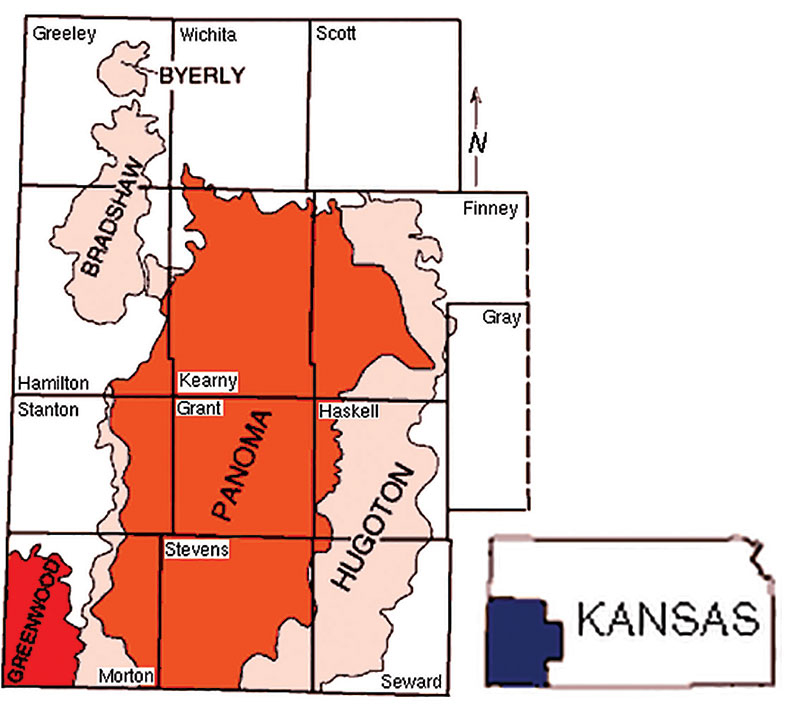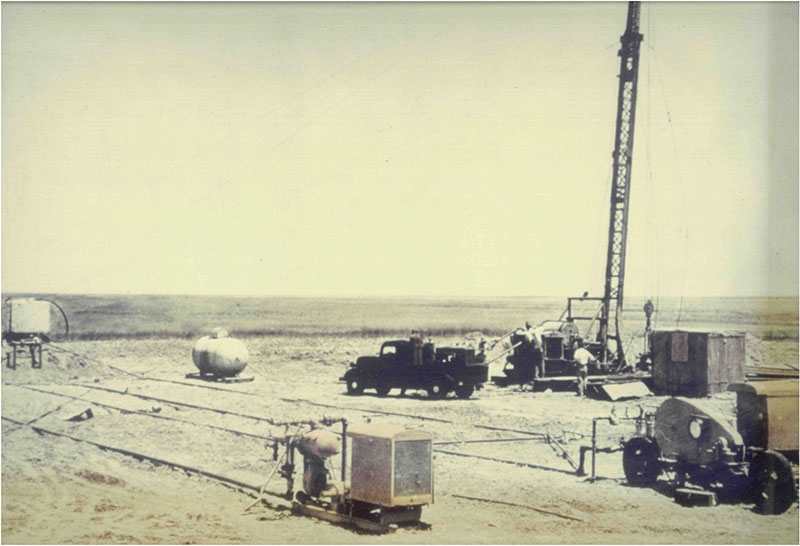The presence of natural gas in Kansas was known in pre-territorial time, as it was escaping from “oil springs” in Miami County in the region’s northeast part – there is some evidence that it was collected and used by local American Indians before any easterners settled in what would become the Sunflower State.

Map of Hugoton and Panoma gas areas, southwest Kansas. Courtesy of Kansas Geological Survey, Public Info Circ. 5.
The presence of natural gas in Kansas was known in pre-territorial time, as it was escaping from “oil springs” in Miami County in the region’s northeast part – there is some evidence that it was collected and used by local American Indians before any easterners settled in what would become the Sunflower State.
Exploration for oil grew after the Civil War, and frequently encountered gas generally was looked upon as a nuisance.
During the 1890s, the Iola gas field, then North America’s largest, was discovered in eastern Kansas. Its result was a boom in regional brick, glass and cement plants, foundries and zinc smelters. But because of profligate use and lack of reservoir management, the giant east Kansas area was nearly depleted by 1910-12 and the industries were shutting down. A few switched to the plentiful coal resources of eastern Kansas.
Some communities used local natural gas and some used manufactured “coal gas” for the next several years. Neither gas nor oil had been found west of Kansas’s Sixth Principle Meridian until sometime after World War I, and one Wichita geologist had predicted, “Nothing would be found west of Wichita.”
However there always seems to be those who ignore prophecies.
Those in this story were members of the Defenders Petroleum and Traders Oil and Gas Company, usually referred to as “Defenders and Traders.”

Stanolind’s first hydraulic fracturing test, 1947, Grant County, Kansas. Courtesy Society of Petroleum Engineers, JPTOnline
First Steps
What possessed Defenders and Traders to wildcat in southwestern Kansas in March of 1919 is lost to history. There was not yet that degree of demand, for gas and oil would not be found in the state’s West Range for four and a half more years.
A big gas well had been completed the preceding December in Potter County in the Texas Panhandle and more successful wells were under way there; perhaps the Panhandle success inspired Defenders and Traders.
At any rate, they spudded a well, the Number 1 Boles, on March 15, 1919, in Seward County, Kansas, in Section 3, Township 35 South, Range 34 West, about 2.9 miles north of the Oklahoma border and 1.75 miles west of the present city limits of Liberal.
By that summer, the Boles was completed at depth of 2,919 feet. There was an up hole gas show in the Permian age Chase Group strata (which defines the Hugoton field as such) but the well remained idle until late in 1922, when it was plugged back to 2,795 feet and completed as a gas well with open flow between five and 10 million CFGPD.
That was the discovery well for the Liberal gas field, which would become the Hugoton field.
The Namesake
There were yet no pipelines in the area and no demands for gas. The area remained idle for five more years until late 1927, when W.M. McNab and the Independent Oil and Gas Company completed the Number 1 Crawford, located 2.8 miles southwest of the little town of Hugoton in Stevens County, Kansas.
The Crawford initially produced about six million CFGPD at IP of 435 PSI, about average virgin pressure for the entire future gas area encompassing the total Texas and Oklahoma Panhandles and southwestern Kansas Permian-age gas field.
The area of the Crawford well was designated the Hugoton field for the nearby town, which was so-named for the French author, Victor Hugo.
By the start of 1929, five more gas wells had been drilled and gas was being locally marketed. That year, Argus Pipeline Co. (a subsidiary of Northern Natural Gas Co.) began constructing an eight-inch line to Dodge City in Ford County. By the end of 1930, six-inch lines were connected to several other small towns in the area.
During the 1920s, seamless pipe was developed and made available to the market and pipeline construction techniques improved. The first large diameter (24-inch) pipe became available in 1925 and radiographic weld testing began in 1931. By then, big cities were losing interest in coal gas manufacturing since reliable quantities of natural gas at a cheaper cost seemed to be available in the Hugoton area.
Not everything was rosy in the 1930s. Severe dust storms caused problems throughout the Great Plains, and the growing Hugoton area was in the thick of it. One such storm excavated a half-mile of buried pipeline near Elkhart in Morton County. A crew from Meade, 95 miles away, was called to inspect and re-bury it.
Boom Town
The gas well and the desire to find oil brought in more people, and Hugoton grew from a town of 644 in 1920 to 1,368 in 1930.
At the end of 1929, there were only four gas wells in the Hugoton Field. However, some trunk lines were being constructed into the area and 1930 ended with 111 wells.
During 1931, only 29 new wells were drilled and well numbers remained constant at 140 for the next four years as the nation wallowed in the Great Depression.
Increased drilling in 1937 resulted in 235 wells at year’s end. Forty of the increase came in Grant County to meet anticipated gas demand for a new carbon black company, the first in the state.
Hugoton drilling remained surprisingly low during the first few years of World War II. At the end of 1945, there were 554 gas wells in the Hugoton and the economy was primed to boom from pent up civilian demand. At the end of 1950, the Hugoton had 2,216 wells; 3,869 by 1958.
By 2012, 10,042 wells had been drilled of which 7,612 were yet producing gas. Field pressure has dropped from around 435 psi in the early days to less than 100 pounds at present and production is declining commensurately. Production during 2011 was 129.4 million MCF, a far cry from 1930’s 716,213 MCF but a substantial drop from the peak year of 1968 that saw 684.9 million MCF.
Hugoton gas, initially consumed locally, eventually made its way by later pipelines as far west as Los Angeles and as far east as Lebanon, Pa., 87 miles west of Philadelphia.
The Hugoton gas area’s Grant County is the location of the first experimental hydraulic fracturing test performed in the oil and gas industry.
In early 1947, Stanolind re-entered its Klepper Gas Unit No. 1 that had been completed the previous November and fractured the Chase strata at the depth of 2,400 feet. A thousand gallons of napalm mix were used with sand from the Arkansas River as a proppant.
No particular gain in production was noted, but Stanolind was sufficiently satisfied to patent the process in 1949 and grant an exclusive license to the Halliburton Well Cementing Co., which proceeded to capitalize it.
Helium, Too
A by-product of the Hugoton (and its southern end, the Panhandle in Texas) is helium. Natural gas produced within bounds of the Hugoton contains from 0.3 percent to 1.9 percent of it depending on location within the area.
It was the primary source for America’s and much of the world’s helium supply for many years. Until 1995, the production and sale of helium gas was a federal government monopoly. At that time, changes in public law turned helium facilities over to private industry.
In 2011, helium was produced by fractional distillation at five plants in Kansas. Minerals Yearbook (2010) reported Kansas’ helium production to be slightly over a billion feet3 valued at $356.7 million.
While helium continues being extracted and well pressure declines, an end is in sight. The 2011 Minerals Yearbook reported:
“The Hugoton and (associated fields in Kansas, Oklahoma and Texas) are depleting fields from which most U.S.-produced helium is extracted. Reserves of the rare gas contain an estimated 140 BCF.”
Still Going, and Going ...
In May 1541, Francisco Vásquez de Coronado entered southwestern Kansas and trekked through the Hugoton area. One of his party recorded (in Spanish): “I am of the belief that it will be productive of all sorts of commodities.”
Helium, trillions of cubic feet of natural gas, millions of tons of carbon black – not to mention multi-billion dollar beef, dairy and grain industries – have proved the prophetic skill of that conquistador.
The Hugoton gas area likely will make it to the century mark before becoming uneconomic. Improved production and engineering methods will recover a few more trillion cubic feet of gas while this historic giant moves toward a century of operations.